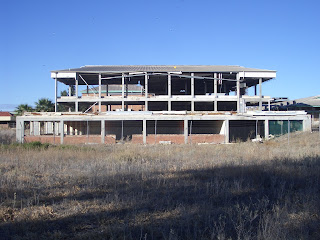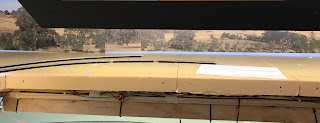It’s been a little over three months since my last update, and I am
happy to once again report that there has been a degree of progress on the
layout. Having a quick look back through this blog, December 3, 2008, was the
first post that outlined my desire to model Gunnedah, and here we are a mere
eight years and a couple of months later, and there is finally track and points
down permanently in what is a slightly condensed representation of Gunnedah
yard.
Of course out of that eight years, actual layout construction only began
roughly twelve months ago, so under the circumstances of this build and the
amount of work that has been done, I am overall very happy.
Unfortunately the past twelve months has also seen a steady progression
with my motor neuron disease, the past three or four months seeing my legs
affected to the point where walking has gone from being slightly challenging to
basically impossible. I can only stand if I am seated on something no lower
than about 62 cm high, and even then can only stand for about 30 seconds or
take about half a dozen steps before my legs basically give out. This has made
it very difficult to even get down to the train room, and while there are
modifications being made with various ramps, and equipment being ordered to help
get down there, it is nonetheless extremely difficult.
However, with the help of family and friends, I still hope to be able to
keep going with the layout and get as much done as possible within whatever
time period I have.
Anyway, I digress slightly, so back to the actual progress.
My Dad spent about a week with me in December, and during this time we
concentrated on getting some track stuck down to the foam underlay in
preparation for it being stuck down to the modules. Point motors were also
attached to each set of points as well as the foam underlay stuck to each set
of points. With about twenty-four sets of points in the Gunnedah yard section
of the layout, that task alone was a substantial one, taking into account that
my Dad is not a modeller in any way, shape or form, so there is a fair degree
of explanation in how everything works. Coupled with the fact that some of the
things I am doing are slightly less than conventional means that I am
experimenting as well, so it is a bit of a task at times!
Starting with the approach to Gunnedah, which on my layout is a single
line of curved track with a radius of about 28 inch, and a single set of points
on a corner module, track and points were permanently attached. As the foam is
less dense than timber/plywood, using track pins is not an option, but after
hearing a few other people using the method successfully, I am
using Parfix silicon sealant to attach the underlay to the track and to the
foam module. A smear of silicon is all that is needed, and once dry provides a
firm bond.
It might seem like a very small step, but seeing that first meter and a
half or so of track and a set of points permanently attached was quite
emotional for me. The decision in the beginning to get the majority of the
layout construction finished before laying any track has paid dividends in a
lot of ways, but it has been a long twelve months or so waiting for track to
permanently begin to be laid so that trains will be able to be run in some
form.
After a small break over Christmas my Dad came up again for another
visit later in January, and this time with some extra help. After discussing
what we were doing with an old friend of his, his friend said that he would be
interested in seeing what we were doing and lending a hand. Whilst not
necessarily knowing a lot about model trains, he has vast experience in
repairing electronic products specifically used in the music industry, wiring
up recording studios etc, and also has a drafting and mechanical engineering
background, so is someone well suited to solving some of the technical
challenges that building a functional layout sometimes present.
The first solution he came up with was in relation to mounting the
lightbulbs which are a visual form of short circuit protection and detection. I
had not put too much thought into the actual design as until that visit not all
of the lightbulbs had even been added to the main bus wiring. After his visit
he emailed me a drawing of what he had in mind, a rather elegant and practical
design that was also simple to make, cheap, adjustable and robust. It is no
more complicated than a length of coathanger wire (or similar), formed into the
appropriate shape which simply wraps around the bulb holder, and then with two
small holes drilled into the timber section that runs around the front of the
layout that the bus wiring is mounted upon.
Once installed in place, the lightbulb bracket is held firmly but is
still easily able to be slid forwards and backwards, so that once the layout
fascia panels go back into place with an appropriately sized hole for the
lightbulb to poke through, the lightbulb position can be adjusted so that they
all poke through the fascia panels by the same amount, I’m thinking the tip of
the bulb will sit about 4-5mm proud of the fascia panel, enough to be seen
easily from any angle when lit but not enough to be easily bumped or be too
obvious.
The January visit also saw track and points go down permanently on the
corner module at the opposite end of Gunnedah yard, which has about five sets
of points as opposed to a single set at the other end, and a pair of these
points which form a crossover will need to operate together at the push of a
single button. I will go into more details on the point motors and their
activation at another time.
With track and points permanently attached to the two corner modules, it
was time to begin the wiring on the underside of the modules. This is where the
modular construction really starts to show its benefits. Being able to lift
each module down and lay the track upon it on a bench in the centre of the room
was much easier than having to lay it in position on the layout, but the
ability to flip modules upside down and work on the wiring at a comfortable
height with it all facing upwards was so much easier than working upside down
at an inconvenient height.
All of the track and points have had red and black dropper wires (and a
green wire off the point frogs) soldered to them prior to being stuck down, and
it was a simple matter of poking a screwdriver through the foam base to make an
appropriate sized hole, and pushing the dropper wires through. With the module
flipped upside down all of the dropper wires are poking through ready to be
joined to the module bus wiring.
With the dropper wires and point motors poking through, it was a simple
matter of running the heavy red and black bus wires in a convenient position
and then soldering the dropper wires to them. The heavy red and black wires are
also brought through the timber frame at the front of the module with a two pin
connector that joints up to the connector on the main bus which runs around the
layout. This system allows for simple electrical connection to each individual
module when they are placed into position on the layout.
I have been very careful to stick to a wiring convention where all
module to bus wiring plugs are wired identically, so that for any testing any
module can be plugged up to any convenient part of the main bus wiring and it
will work.
Whilst track wiring is relatively simple as it is basically red and
black wiring, the point motors introduce a slightly greater degree of
difficulty. I am using the Cobalt iP Analog point motors from DCC Concepts in
Western Australia. They essentially use a five wire system, two wires for the DC
switching to move the points left and right, the red and black dropper wires
from the track go to two other positions, with a green wire that comes from the
point frog going to the fifth position. As the points are switched from left to
right the polarity of the frog is changed accordingly.
As Gunnedah yard has a large number of points, I wanted to be able to
identify the trigger wiring for switching points easily, and as a few sets of
points form crossovers were a pair of points will always be switched together,
it made sense to use a combination of wire colours to identify a particular set
based on their orientation and being a single set or a pair forming a
crossover.
Essentially each set of points is identified as being left-hand
clockwise, right-hand clockwise, left-hand anti clockwise and right-hand anticlockwise.
This gives four combinations, all of which are noted in an exercise book I have
which clearly identifies all wiring, plugs, transformers etc for future
reference, troubleshooting etc.
Each point motor is also identified depending on which module it is on and
its number, so once the trigger wires are run from the point motors in their
various colour combinations, they are also marked with what points they are
coming from. In theory this should mean when it comes time to plug all of these
wires up to the boards that handle the point activation, it should be very
simple to identify which is which.
For the time being whilst the modules can be tested to make sure
everything is working properly, the wiring has been temporarily held in place
with masking tape. Once a degree of testing has been completed and I am
confident there are no issues a more elegant and permanent solution will be
used to retain the wiring in place.
Following January’s visit, my Dad came up for another visit in February
and his mate also came up for a couple of days, this visit saw about 80% of the
track in the middle section of Gunnedah yard permanently attached, and about
60% of the wiring underneath the module completed. This centre module contains
the bulk amount of track and points, and will be by far the most time-consuming
part of the layout to get operational. Hopefully further visits will see this
part of the layout completed, at least as far as track work goes, which can
then be tested and trains run finally.
Cheers
Darren










































